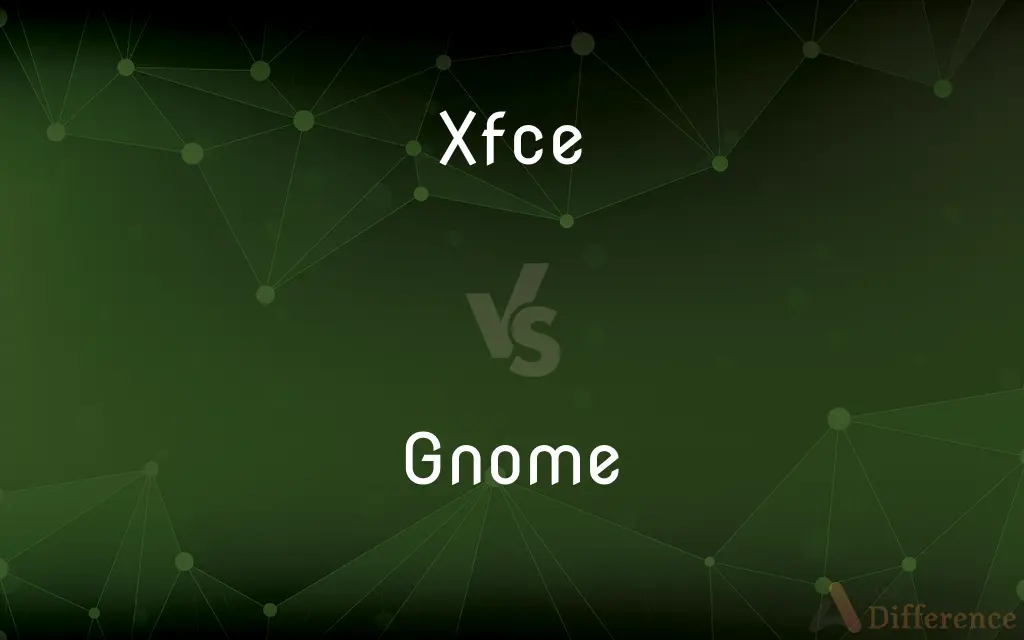XFCE vs. GNOME — What's the Difference?
By Tayyaba Rehman — Updated on November 3, 2023
XFCE is a lightweight desktop environment known for its efficiency and modularity, while GNOME is a feature-rich and user-friendly desktop environment with a focus on a clean and simple interface.

Difference Between XFCE and GNOME
Table of Contents
ADVERTISEMENT
Key Differences
XFCE and GNOME are both desktop environments for Linux operating systems, but they cater to different user preferences. XFCE is designed for users who desire a lightweight and highly customizable interface, which uses less system resources. GNOME, on the other hand, aims to provide a more streamlined and modern user experience with an emphasis on usability and accessibility.
XFCE stands for XForms Common Environment, and it embodies the traditional desktop metaphor with a customizable panel and desktop icons. It is well-regarded for its speed and lower resource consumption, making it suitable for older hardware. GNOME (GNU Network Object Model Environment), in contrast, takes a minimalist approach, opting for a clutter-free and intuitive interface that eschews on-screen complexity for ease of use.
The design philosophy between XFCE and GNOME is quite distinct. XFCE offers a more conventional user interface where users can easily make extensive modifications. GNOME, meanwhile, adopts a less is more philosophy, providing a simplified interface that reduces the ability to make modifications but focuses on delivering a seamless user experience.
While XFCE provides a stable and consistent performance over time, GNOME is known for introducing significant changes with its major releases, which can often alter the user interface and experience. This means XFCE can be more predictable over the long term, while GNOME users may need to adapt to interface changes after updates.
XFCE is often the choice for users who have specific needs for their desktop environment or who are looking to repurpose older hardware. GNOME, however, is typically selected by users who prioritize design elegance and ease of use over the ability to customize or the need to conserve system resources.
ADVERTISEMENT
Comparison Chart
Resource Efficiency
Uses fewer resources, good for older systems.
More resource-intensive, best for newer systems.
User Interface
Classic, highly customizable interface.
Modern, streamlined interface with less customization.
Design Philosophy
Modular and traditional desktop layout.
Simplistic and user-centric design.
System Compatibility
Suitable for a wider range of systems, including less powerful ones.
Targeted at more powerful, modern systems.
Typical User
Users seeking customization and efficiency.
Users preferring ease-of-use and aesthetics.
Compare with Definitions
Xfce
An open-source desktop environment with a traditional graphical user interface.
XFCE provides a familiar desktop interface that longtime Linux users appreciate.
Gnome
GNOME is a user-friendly desktop environment aimed at providing a simple and elegant interface.
I love the clean look of GNOME on my desktop computer.
Xfce
A modular desktop environment known for its speed and lower resource demand.
The latest XFCE update offers even more tools for system monitoring.
Gnome
An open-source desktop environment that prioritizes a minimalistic approach.
The new version of GNOME has even fewer on-screen controls for a cleaner look.
Xfce
XFCE is a stable and conservative choice for users valuing performance.
XFCE hasn't changed much over the years, and that's perfect for my workflow.
Gnome
GNOME desktop is part of the GNU Project and focuses on network transparency and integration.
GNOME seamlessly integrates with my cloud services.
Xfce
XFCE is a lightweight and customizable desktop environment for Unix-like operating systems.
I prefer XFCE for my old laptop because it runs faster than other desktop environments.
Gnome
GNOME is known for its emphasis on design and seamless user experience.
Switching to GNOME was easy because of its intuitive design.
Xfce
XFCE allows detailed customization for advanced users.
Customizing my panel and window manager in XFCE is a straightforward process.
Gnome
A gnome is a mythological creature and diminutive spirit in Renaissance magic and alchemy, first introduced by Paracelsus in the 16th century and later adopted by more recent authors including those of modern fantasy literature. Its characteristics have been reinterpreted to suit the needs of various story tellers, but it is typically said to be a small humanoid that lives underground.Diminutive statues of gnomes introduced as lawn ornaments during the 19th century grew in popularity during the 20th century and came to be known as garden gnomes.
Xfce
Xfce or XFCE (pronounced as four individual letters) is a free and open-source desktop environment for Unix-like operating systems. Xfce aims to be fast and lightweight while still being visually appealing and easy to use.
Gnome
One of a fabled race of dwarflike creatures who live underground and guard treasure hoards.
Gnome
In the occult philosophy of Paracelsus, a being that has earth as its element.
Gnome
A pithy saying that expresses a general truth or fundamental principle; an aphorism.
Gnome
A brief reflection or maxim; a pithy saying.
Gnome
An elemental (spirit or corporeal creature associated with a classical element) associated with earth.
Gnome
One of a race of imaginary human-like beings, usually depicted as short and typically bearded males, who inhabit the inner parts of the earth and act as guardians of mines, mineral treasure, etc.; in modern fantasy literature and games, when distinguished from dwarves, gnomes are usually even smaller than dwarves and more focussed on engineering than mining.
Gnome
A person of small stature or misshapen features, or of strange appearance.
Gnome
The northern pygmy owl, Glaucidium gnoma, a small owl of the western United States.
Gnome
A small statue of a dwarf-like character, often bearded, placed in a garden.
Gnome
An upper atmospheric optical phenomenon associated with thunderstorms, a compact blue starter.
Gnome
A banker, especially a secretive international one.
The gnomes of Zurich
Gnome
An imaginary being, supposed by the Rosicrucians to inhabit the inner parts of the earth, and to be the guardian of mines, quarries, etc.
Gnome
A dwarf; a goblin; a person of small stature or misshapen features, or of strange appearance.
Gnome
A small owl (Glaucidium gnoma) of the Western United States.
Gnome
A brief reflection or maxim.
Gnome
A legendary creature resembling a tiny old man; lives in the depths of the earth and guards buried treasure
Gnome
A short pithy saying expressing a general truth
Gnome
A contemporary desktop environment focusing on usability and accessibility.
GNOME's accessibility features make it a top choice for users with disabilities.
Common Curiosities
What makes GNOME stand out from XFCE?
GNOME stands out for its modern design, ease of use, and strong focus on a streamlined user interface.
Can XFCE look as modern as GNOME?
With customization, XFCE can be made to look more modern, but it generally has a more traditional aesthetic.
Is GNOME heavier on system resources than XFCE?
Yes, GNOME typically requires more system resources than XFCE.
Is XFCE a good choice for Linux beginners?
XFCE can be a good choice for beginners who want to learn about customization and prefer a classic interface.
Can XFCE run on all Linux distributions?
XFCE can run on most Linux distributions that support X11.
What is XFCE best used for?
XFCE is best used for creating a fast and responsive computing experience, especially on older or less powerful hardware.
Does GNOME offer extensions for added functionality?
Yes, GNOME offers extensions that can add functionality and alter the user experience.
Is GNOME the default desktop for any Linux distributions?
Yes, GNOME is the default desktop for several distributions, including Ubuntu and Fedora.
How does user support compare between XFCE and GNOME?
Both have strong user communities and extensive documentation, but GNOME's larger user base may provide more community support resources.
Are both XFCE and GNOME customizable?
Both are customizable, but XFCE offers more options for customization than GNOME.
Can XFCE emulate GNOME's look and feel?
With extensive customization, XFCE can be tweaked to resemble GNOME's look to some extent.
Do both XFCE and GNOME receive regular updates?
Yes, both desktop environments have active development communities and receive regular updates.
Can I use the same applications in both XFCE and GNOME?
Yes, most applications designed for Linux will work in both XFCE and GNOME.
Is it easy to switch from XFCE to GNOME or vice versa?
Switching between desktop environments can be straightforward, but it depends on the Linux distribution.
Are there any specific hardware requirements for GNOME?
GNOME requires a more powerful system to run smoothly compared to XFCE, including a capable graphics processor for the best experience.
Share Your Discovery

Previous Comparison
Baron vs. Duke
Next Comparison
Advance vs. PrepaymentAuthor Spotlight
Written by
Tayyaba RehmanTayyaba Rehman is a distinguished writer, currently serving as a primary contributor to askdifference.com. As a researcher in semantics and etymology, Tayyaba's passion for the complexity of languages and their distinctions has found a perfect home on the platform. Tayyaba delves into the intricacies of language, distinguishing between commonly confused words and phrases, thereby providing clarity for readers worldwide.














































